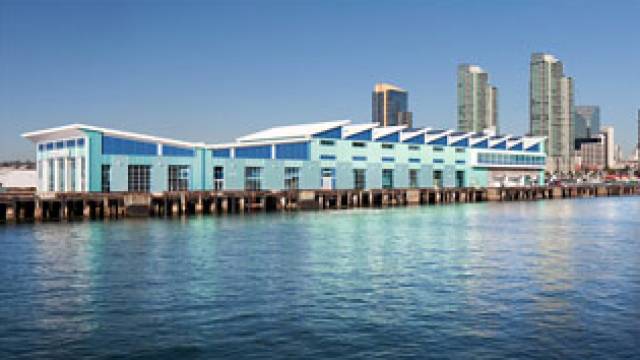PPG’s DURANAR® VARI-COOL® coatings are used for the Port Pavilion on Broadway Pier in San Diego. In a nationwide survey of architects, PPG coatings ranked second for leadership in coatings sustainability. Duranar VARI-Cool coatings change colour depending on the angle from which they are viewed and, compared to conventional metal coatings, help buildings stay cooler and use less energy.
The use of building-integrated clean energy sources is expected to grow, according to a new survey of architects commissioned by PPG Industries. The study also found that while the volume of work for US architectural firms overseas has remained steady, they are completing more projects in China, Canada and the Middle East.
The PPG survey indicated that architects are almost evenly split on whether they have specified clean-energy generating elements, such as solar panels and mini wind turbines, for building projects. While 42% of respondents reported having done so, nearly three-quarters (74%) said they expect to do so in the future. Most said they see new incentives and falling technology prices driving this trend, as well as the positive sentiment associated with clean energy.
When asked to name the most important characteristics for green building product selection, architects cited product durability most often, followed by life-cycle assessment, product certification and product transparency. When choosing a building product manufacturer, they said product durability was the most critical feature, narrowly leading customer responsiveness, product warranties, product features and technical support.
Consistent with PPG’s last survey in 2008, 30% of participating firms reported doing work outside the US. In contrast, though, the number of firms completing projects in China doubled from 15% to 30%, in Canada increased from 16% to 27% and in the UAE jumped from 8% to 22%. Fourteen per cent of firms reported projects in India, followed by 13% in Saudi Arabia and 12% in the UK.
Manufacturer websites (86%) remain the primary source of product information for architects. Search engine use (72%), which has more than doubled since 2006, was next. Traditional sources of product information such as manufacturer representatives (63%) and printed binders (43%) remain popular as well.
Among the additional survey findings:
- PPG was named by 25% of responding architects as a top green building company. Category leaders were Armstrong at 43%, and at 38% each Lutron Lighting, Owens-Corning and USG;
- Among architectural glass manufacturers, PPG was named by 42% of respondents as a sustainability leader, far outpacing Pilkington/NSG (11%) and Viracon (10%). PPG also was named as the most preferred architectural glass brand (49%), topping runners-up Viracon (17%) and Oldcastle (12%);
- PPG was the second most frequently identified brand for leadership in coatings sustainability (14%), trailing only KYNAR 500® coatings (45%). Among the most preferred exterior fluoropolymer coatings brands, PPG was second (6%) and DURANAR® coatings fourth (3%);
- PPG PITTSBURGH PAINTS® brand was mentioned by 5% of responding architects as a sustainability leader for paint, making it third in that category. PPG PORTER PAINTS® joined a cluster of paint brands at 1% awareness;
- PPG was the fifth most recognized brand (with unaided awareness) in the building products industry, behind USG, Armstrong, Kawneer and CertainTeed.
The online survey was completed by 686 qualified architects, producing ±3.7% accuracy at the 95% confidence level. It reached a representative cross-section of US architects by firm size, geography, job title and years of experience.




